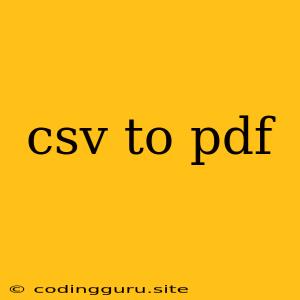Converting CSV to PDF: A Comprehensive Guide
Converting CSV (Comma Separated Values) data to PDF (Portable Document Format) is a common task in various fields, including data analysis, reporting, and document management. This guide will explore different methods and tools to convert CSV files to PDF, helping you choose the most appropriate approach for your specific needs.
Why Convert CSV to PDF?
CSV files are excellent for storing and sharing data in a tabular format. However, they lack the formatting capabilities and security features offered by PDFs. Converting your CSV data to PDF provides several advantages:
- Improved Readability and Presentation: PDFs allow you to format data with fonts, colors, and tables, enhancing visual appeal and readability.
- Data Security: PDFs offer greater protection against accidental modification or data corruption compared to plain CSV files. You can password-protect PDFs, limiting access to sensitive information.
- Standardized Format: PDFs ensure consistent viewing across different devices and operating systems, ensuring your data is displayed correctly regardless of the user's software.
- Ease of Sharing and Archiving: PDFs are universally compatible and can be easily shared and archived.
Methods for CSV to PDF Conversion
1. Using Spreadsheet Software:
- Microsoft Excel: Excel is a popular choice for converting CSV to PDF. Open your CSV file in Excel, navigate to "File" > "Save As," and choose "PDF" as the file type. Excel allows customizing settings for PDF output, including page layout, margins, and password protection.
- Google Sheets: For online conversion, Google Sheets offers a similar method. Open your CSV file in Google Sheets, select "File" > "Download as" and choose "PDF document." You can also adjust settings for page orientation and format.
- Other Spreadsheet Software: Most spreadsheet software, such as LibreOffice Calc, OpenOffice Calc, or Numbers, provides options to save CSV data as PDFs. Refer to the software's documentation for specific steps.
2. Online Converters:
Numerous online converters offer free or paid services for CSV to PDF conversion. These web-based tools are convenient for quick conversions and often provide additional options like column formatting, header customization, and page layout.
3. Programming Languages:
For advanced users, converting CSV to PDF can be achieved using programming languages like Python, Java, or JavaScript. Libraries like pandas and reportlab (Python), itextpdf (Java), and pdfkit (JavaScript) facilitate the conversion process. These tools offer greater control over the final PDF document, enabling complex formatting and data manipulation.
4. Dedicated Software Tools:
Specialized software tools designed for document creation and conversion offer powerful features for CSV to PDF conversion. Some popular choices include:
- Adobe Acrobat: Adobe Acrobat is a comprehensive PDF solution that provides advanced conversion capabilities. You can use Acrobat's "Combine Files" feature to import your CSV file and convert it to a PDF document.
- Nitro Pro: Nitro Pro offers similar functionalities to Adobe Acrobat, including CSV to PDF conversion, with features like page layout customization and document security.
- PDF Converter Pro: PDF Converter Pro is another software tool that specializes in document conversion, including CSV to PDF conversion, and offers various editing and formatting options.
Tips for Effective CSV to PDF Conversion
- Data Cleaning: Before conversion, ensure your CSV data is clean and free of errors. Check for inconsistencies, missing values, and incorrect data types.
- Format and Style: Choose appropriate fonts, colors, and table styles to enhance readability and visual appeal.
- Page Layout: Optimize page layout to avoid unnecessary page breaks and maintain a professional look.
- Security Features: If necessary, use password protection, encryption, or digital signatures to secure your PDF document.
- Test and Refine: After conversion, review the PDF document for accuracy and make necessary adjustments to your settings.
Example: CSV to PDF with Python
Here's an example demonstrating CSV to PDF conversion using the pandas and reportlab libraries in Python:
import pandas as pd
from reportlab.pdfgen import canvas
from reportlab.lib.pagesizes import letter
# Load CSV data
data = pd.read_csv('data.csv')
# Create a PDF canvas
c = canvas.Canvas('data.pdf', pagesize=letter)
# Add table data to the canvas
c.drawString(50, 700, 'My Data Table')
data.to_html('temp.html', index=False)
c.drawString(50, 650, data.to_html('temp.html', index=False))
# Save the PDF file
c.save()
This example imports the pandas library to read the CSV file, reportlab.pdfgen.canvas to create a PDF canvas, and reportlab.lib.pagesizes to define the page size. The code then writes the table data to the canvas and saves the PDF file.
Conclusion
Converting CSV data to PDF offers numerous benefits, including improved readability, data security, and ease of sharing. This guide provided different methods for converting CSV to PDF, from spreadsheet software to online converters and programming languages. Choosing the best approach depends on your specific needs and technical expertise. Remember to clean your data, format your PDF document, and test your results for optimal accuracy and presentation.
